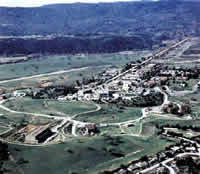![]()
In order to peer deep within the atom to determine the basic building blocks of matter, physicists use particle accelerators, multi-million dollar facilities designed to accelerate charged particles to very high velocities. These particles, usually protons and antiprotons or electrons and antielectrons are then smashed into each other, releasing tremendous amounts of energy and producing new types of matter, some of which hasn't been around since the beginning of the time! Sensitive detectors are used to "see" these new particles. These laboratories are the microscopes of the high energy physics world.
Below is a brief description of three of these labs, with links to their web pages for a more detailed summary of the exciting physics taking place at these facilities. There are many more labs like these around the world doing a whole variety of research. For a listing of more labs, follow this link to Fermilab's "Inquiring Minds" page.
 |
Fermilab
Located in Batavia,
Illinois, outside of Chicago, Fermilab is currently the most powerful
particle accelerator lab in the world, accelerating protons and antiprotons
to energies close to one trillion electron volts each (that translates
to speeds just barely slower than the speed of light!)
The particles begin their journey in the linear accelerator, a 500 foot
long pipe wich gives them their initial push (it is too small to see in
this view of the lab). They then move to the main injector which is the
small ring to the left and finally to the large ring on the right, the "Tevetron",
the final stage in the particles' journey, which has a circumferance of
about 4 miles. At two seperate locations along this ring the proton and
antiproton beams cross and the particles collide. The two main detectors,
D-Zero and CMF are located at these points.

